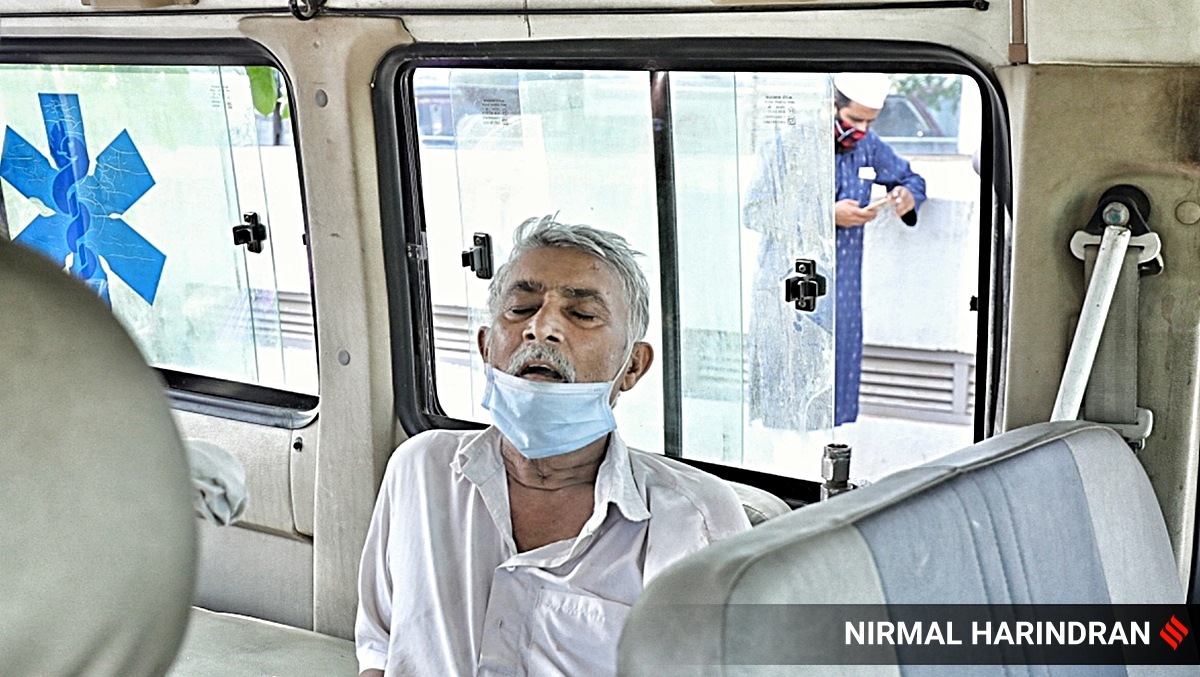 A Coronavirus patient inside an ambulance. (Express Photo by Nirmal Harindran)
A Coronavirus patient inside an ambulance. (Express Photo by Nirmal Harindran) The possible SARS-nCov virus variant behind the current surge in the Covid-19 cases in India was traced back in December from the samples collected from a part of Maharashtra. But it was not flagged as it was still a variant with an unknown character, that too, detected when the cases in India were on a decline, said Anurag Agrawal, director, CSIR – Institute of Genomics and Integrative Biology (IGIB).
He was speaking at a panel discussion organised as part of a webinar titled ‘Genome Sequencing of SARS-nCov-19’, organised by the Department of Biotechnology (DBT), on Friday.
Agrawal said, “The first sequences of the so called Indian variant B.1.617 were seen in December, but we were in a defining phase. We see hundreds of mutations when every time we sequence. There was absolutely no reason to flag a variant or a mutation of an unknown character in a declining phase of an outbreak.”
But samples from a part of Maharashtra began to show some signs. Since Maharashtra is a large state and so is India, a large country, there is no one Indian strain, the experts said.
“From a part of Maharashtra, L452R mutation was being seen along with E484Q in an increasing number of samples during the outbreak that started in January and it was flagged,” said the IGIB director.
Genome sequencing in India started only after the UK confirmed a new corona virus variant in November last year in a possible fresh wave. Indian scientists were roped into the SARS CoV2 Genome Sequencing Consortium (INSACOG) — a 10-institution team, tasked with performing genome sequence and surveillance, began sequencing here.
Generally, genomic sequencing can include studying the bio-chemical or bio-physical characteristics done mainly to generate an accurate sequence of a virus strain.
“A ‘variant of interest’ was identified and all necessary tests were performed. By the end of March, this variant was moved from a ‘variant of interest’ to a ‘variant of concern’. After obtaining the samples from cases and vaccines, we can now co-relate backwards in an outbreak starting in January and till March end,” he added.
Along with IGIB, labs in this consortium include National Institute of Virology (NIV), National Institute of Biomedical Genomics (NIBMG), National Centre for Disease Control (NCDC), Regional Centre for Biotechnology (RCB) and others.
“Despite all the precautions taken, there was an explosion of cases as the UK found the variant B.1.1.7 during October and November last year. After three months of carrying out extensive sequencing, the UK scientists could trace this variant, which had first emerged (there) in September,” said Agrawal.
Virus mutations are natural, said Shekhar Mande, director general of the Council of Scientific and Industrial Research (CSIR).
Other panellists attributed the spike in the cases to a combination of factors, including lack of adherence to Covid-appropriate behaviour and declining immunity of people.
“The sudden surge in the cases is not alone because of the virus strains but multiple factors like complacency in following Covid-appropriate behaviour, immunity, adoption of public health measures to contain the transmission from time-to-time and the rising immune escape mutations,” said NCDC Director Sujeet Singh.
DBT Secretary Renu Swarup said more satellite laboratories will be opened, which will work in tandem with the consortia that will act as nucleus in carrying out the sequencing works.
During the ongoing wave, instances of RT-PCR tests failing to capture the virus and thus reporting false negative test results emerged.
Addressing this issue, NIV Director Priya Abraham said RT-PCR remains the gold standard test and normally it is able to pick all strains of virus.
“This unless, either the patient’s sample collection has been done over seven days after getting infected or showing up of symptoms or compromise or damage to samples during transportation,” said Abraham.
- The Indian Express website has been rated GREEN for its credibility and trustworthiness by Newsguard, a global service that rates news sources for their journalistic standards.

